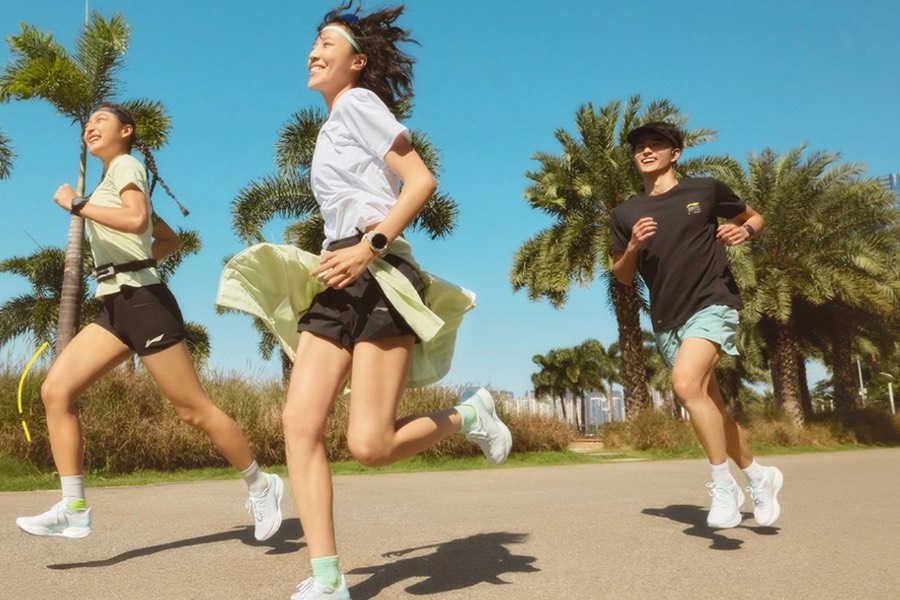Could consumer stimulus send Li Ning stock vaulting higher?

The sportswear maker’s gross margin rose by 1 percentage point last year as it boosted its dividend payout ratio to 50%
Key Takeaways:
- Li Ning’s net profit declined last year, mainly due to impairment provisions related to falling values for some of its properties
- Despite a strong showing for its running shoe business last year, the sportswear maker is valued lower than rival Anta
By Bai Xinrui
It may be named for one of China’s first Olympic champions, but leading sportswear maker Li Ning Co. Ltd. (2331.HK) was a loser last year, as its stock sank 21% in 2024, even as the broader Hang Seng Index rallied 17%. But strong government support for sports in China could put some spring back into its step, reflected by the company’s solid performance last year in its latest annual results released late last month.
China’s sportswear market has long been dominated by Li Ning and archrival Anta (2020.HK), each regularly trying to one-up the other as Chinese sports enthusiasts increasingly embrace domestic brands. Anta reported impressive results last year, including a 52.4% jump in its profit and 13.6% revenue gain.
Li Ning failed to outshine its larger rival last year, but still managed to grow its revenue by 3.9% to 28.68 billion yuan ($3.95 billion). Footwear products remained its core segment, generating 14.3 billion yuan, while apparel sales brought in 12.05 billion yuan. The company’s gross profit margin for the year improved 1 percentage point to 49.4%, helped by a bigger contribution from higher-margin online channels that made up 29% of total sales. That helped to boost its operating profit by 3.3% to 3.68 billion yuan for the year.
Running shoe business sprints ahead
Li Ning’s running shoe business was its all-star performer last year, posting 25% sales growth for the year. According to a Guosen Securities report published in February, the average price of Li Ning’s running shoes has been rising for the past few quarters, helping the category’s sales growth to accelerate. Its Rouge Rabbit series has seen steady gains in market share, contributing 40% of the segment’s revenue.
Despite the revenue and gross margin increases, Li Ning’s net profit moved in the other direction, falling 5.5% to 3.01 billion yuan last year. The decline owed partly to a 330 million yuan impairment provision related to falling prices in the Chinese property market, which clearly is not related to its key core business.
At the operational level, Li Ning’s average inventory turnover time increased slightly by 1 day to 64 days, while its trade receivables period dropped by 1 day to 14 days and its net cash reserves rose slightly to 18.16 billion yuan. The company also increased its dividend payout ratio by 5 percentage points to 50%, showing its confidence in its future.
Li Ning and other retailers may be benefitting from recent signs of stability in China’s stock and property markets, prompting consumers to relax their spending after being thrifty for much of last year. China’s latest economic data shows the country’s retail sales rose 4% year-on-year in the first two months of 2025, accelerating from a 3.7% increase last December, signaling a potential rebound may be brewing for the retail sector.
Despite those positive signs, Li Ning’s management was still cautious and emphasized stability over all else. CFO Zhao Dongsheng forecast the company’s revenue would be flat this year, while predicting its net profit margin would reach high single-digits. Joint-CEO Kosaka Takeshi stressed that the company’s current approach is not one of conservatism, but rather incorporates “defense, offense and control” all at once.
The central government’s work report given out last month said China will work to “vigorously boost consumption,” with an emphasis on sectors such as catering, transportation, major events and sports tourism. Since the sports sector accounts for an average 2% to 3% of GDP in most developed economies, and is just 1% in China, it stands to reason that China’s sports sector will continue to grow as it plays catchup with more developed markets.
According to the Chinese State Council’s 14th Five-Year Plan for sports development and national fitness through 2025, China’s sports industry will reach over 5 trillion yuan in scale by 2025, providing a feast for both domestic and foreign brands.
While Anta and Li Ning are the country’s two biggest brands, Li Ning’s revenue last year was only 40% that of Anta’s 70.83 billion yuan. Li Ning’s biggest challenge right now lies in its basketball business, whose revenue dropped 21% last year due to distribution channel disruptions. If it can right that ship, together with the strong growth in its running shoe business, the company could return to profit growth next year and perhaps even close its gap with Anta.
Lowly valued
Li Ning also looks strong for its cash position, which it can use to acquire domestic or foreign peers to boost its business. Analysts also expect the company to return to profit growth this year, forecasting a 10% rise. Despite that, Li Ning trades at a forward price-to-earnings (P/E) ratio of only 12 times. Anta trades at a higher 16, even as analysts expect its core net profit to fall 11% this year. That seems to show that Li Ning, after its weak stock performance last year, could make up some ground on Anta in 2025, at least in terms of valuation metrics.
At the broadest level, Beijing’s strong commitment to sports development as part of its bigger plans to boost domestic consumption will not only stimulate sportswear sales but could also boost related stocks. Other factors, such as the potential for Li Ning to beat its own conservative targets and the low valuation for its stock, could lay the groundwork for the company’s shares to finally break out of their slump in 2025.
To subscribe to Bamboo Works weekly free newsletter, click here





